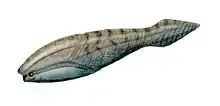Arandaspis
Arandaspis prionotolepis is an extinct species of jawless fish that lived in the Ordovician period, about 480 to 470 million years ago. Its remains were found in Alice Springs, Australia in 1959, but it was not determined that they were the oldest known vertebrates until the late 1960s. Arandaspis is named after a local Aboriginal tribe, the Aranda (now currently called Arrernte).
| Arandaspis | |
|---|---|
 | |
| Fossil of Arandaspis prionotolepis from Natural History Museum in London | |
| Scientific classification | |
| Kingdom: | Animalia |
| Phylum: | Chordata |
| Superclass: | Agnatha |
| Class: | †Pteraspidomorphi |
| Family: | †Arandaspididae |
| Genus: | †Arandaspis Ritchie & Gilbert-Tomlinson, 1977 |
| Type species | |
| †Arandaspis prionotolepis Ritchie & Gilbert-Tomlinson, 1977 | |
| Species[1] | |
| |
Description

Arandaspis was about 15 cm (6 in) long, with a streamlined body covered in rows of knobbly armoured scutes. The front of the body and the head were protected by hard plates with openings for the eyes, nostrils and gills. It probably was a filter-feeder.
It had no fins; its only method of propulsion was the use of its vertically flattened tail. As a result, it probably swam in a fashion similar to a modern tadpole.[2]
See also
References
- "Pteraspidomorphi". Retrieved 28 October 2013.
- Palmer, D., ed. (1999). The Marshall Illustrated Encyclopedia of Dinosaurs and Prehistoric Animals. London: Marshall Editions. p. 23. ISBN 1-84028-152-9.
| Wikimedia Commons has media related to Arandaspis. |